How Russian armor fought. CH 1. At Strykov and Pabianice
The construction of armored cars in Russia began immediately after the start of the First World War.
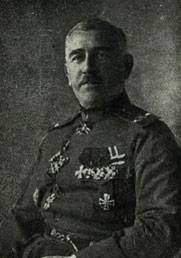
1. A. N. Dobrzhansky
17. 08. 1914, the military minister, cavalry general V. A. Sukhomlinov, summoning one of the best shooters of the Russian Guard, Colonel A. N. Dobrzhansky, invited him to form and head an "armored machine-gun battery". The task was completed in record time, and Alexander Nikolayevich headed the 22 for September at the 1 Machine Gun Company. And in October of the same year, the company moved to the front.
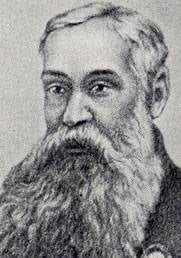
2. N.M. Filatov.
Initially, the unit included 8 machine guns (on the Russo-Balt chassis) and 1 guns (on the chassis of the Manesman-Mulag 5-ton truck; weapons of the 47-mm naval gun) armored vehicles. In addition, the company had 2 (then 4) of a truck with 37-mm Maxim-Nordenfeld automatic cannons.
Major-General N. M. Filatov, the head of the Officer Infantry School, was also involved in the formation of armored car units of the Russian army — officers of his initiative, who expressed a desire to serve in these units, were sent to the Military Automotive School (which had a special armor department).
The mission of the commander of the Automobile Training Company, Colonel P. I. Sekretev, contributed to the replenishment of the armored vehicle of the Russian army - it had to order automobile and armored vehicles in the UK (the Russian-Baltic car factory did not have enough power yet).
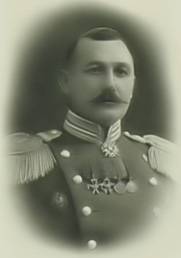
3. PI Sekretov.
The following number of armored vehicles on the chassis was acquired: Austin - 48, Renault - 40 and "Isotta Frascini" - 1. The arrival of the “Austinov” (this type became the most massive armored car of the Russian army) allowed (after rebooking at the Izhora plant - the British armor was extremely weak) to begin the formation of automotive machine-gun platoons, which initially consisted of three armored vehicles.
The need for cannon armored cars led to the fact that, at the beginning of 1915, work began on booking the 4-ton American Garford (Garford Putilovets) cars armed with 76-mm anti-assault cannon and 3 machine guns at the Putilov plant. In the new state, each automobile machine-gun platoon had to have 2 machine guns and cannon armored vehicles.
In the spring of 1915, Renault armored cars began to arrive in Russia (disassembled). Armed with a machine gun, without having a horizontal reservation, they were used in armored vehicles for the delivery of ammunition (mainly to cannon armored vehicles), and 11 units were transferred to Izhora plant - for booking by headquarters captain Mgebrov.
4. Armored car on the chassis Renault. Niva. 1915. No. 30.
The system Mgebrova was armored 16 machines: "Renault", "White", "Pierce Arrow", "Benz", "Izotta-Fraschini", "Russo-Balt". The Mgebrov machines were distinguished by the perfect forms of armored corps (designed for ricochet) and 2-machine-gun turrets of the original design.
In the Petrograd workshops of A. Bratolyubov, 11 machines were also reserved by the system of staff captain Nekrasov (10 Russo-Balt and Renault), and at the Obukhov plant under the leadership of staff captain Bylinskiy 3 machines were booked (2 Mercedes and " Lloyd "). The latter had to act together with the cavalry: "Lloyd" had two, and "Mercedes" - on one machine-gun turret ("Mercy" was also armed with 37-mm cannons mounted on pedestals in the stern of the hull). "Lloyd" and "Mercedes" manned 25-th automotive machine-gun platoon.
5. Armored cars Austin. Niva. 1915. No. 30.
In the second half of 1915 - in the spring of 1916, 161 armored vehicles arrived in Russia from abroad (60 “Austin” 2-series, 36 “Armia-Motor-Lories”, 30 “Armstrong-Whitworth-Fiat”, 25 “Sheffield Simplex ", 10" Armstrong-Whitworth-Jarrot "). Only the Austins turned out to be suitable for combat use, and the rest had to be refined and eliminated the shortcomings. “Fireworks” and “Fiats” began to arrive at the front only at the end of 1916, while “Sheffilds” and “Army” did not get into the active army (one “Sheffield-Simplex” was turned into armored rubber, the rest - did not make it).
For the staffing of the cannon compartments of the new series (formed from the “Austins” of the 2 series) of the auto-gun platoons, a new cannon armored car was needed. Then 37-mm Hotchkiss gun armed 22 armored car "Lanchester", destined for the British armored division - and since the summer of 1916, the new gun armored vehicles were successfully used on the Russian front.
6. Autopulp gun platoon of the Russian army. One can see “Lanchester”, two “Austin” cars and motorcycles. Armored collection. 1997. No. 1.
In summer, the booking began (according to the Captain Poplavko system) 30 of Jeffrey trucks - later the Special Purpose Division was formed from them. And the Putilov factory was given the order to develop a cannon armored car based on the FWD truck - and in October 1916, an unarmored chassis with an 76,2-mm field gun installed on it, the 1902 model, was successfully tested. It was decided to reinforce the armament by installing a linear (42-mm) cannon on the 107 machine with excellent ballistic data (the armored car actually became a self-propelled gun), but after February 1917, the work was stopped.
7. "Caucasian" - "Austin" 1-series. 45-rk squad, October 1916, the armored collection. 1997. No. 1.
In September 1916, the armored units of the Russian army moved to the divisional structure. In addition to the Special Purpose Division, the 12 Armored Divisions, the English and the Belgian armored divisions were formed. Each division included an 3 - 4 autobunker platoon. The platoon organization remained where it was appropriate - for example, on the Caucasian front.
In addition to the acquisition of 60 "Austin", it was decided to organize a large-scale booking of automobile chassis in Russian factories. For this purpose, 150 chassis (90 Fiat and 60 Austin) were acquired - the Putilov and Izhor factories took over the booking. Due to delays in the delivery of the chassis, work was disrupted - by October 1817 only the Fiat 41 chassis was booked.
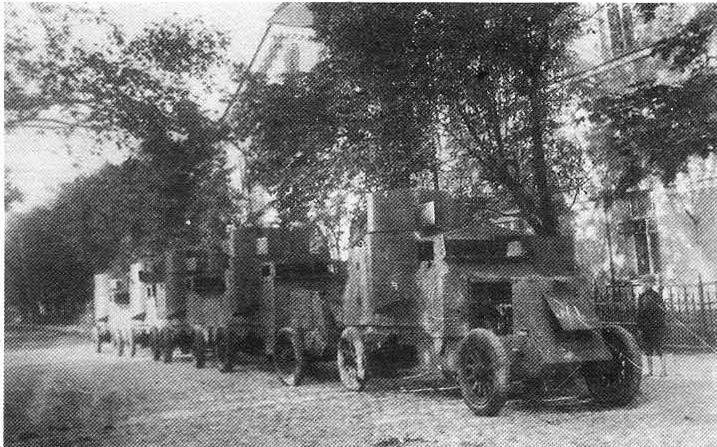
8. Russian "Austin" Izhora plant. Armored collection. 1997. No. 1.
Simultaneously at the Obukhov Plant, the 31 chassis “Packard” was booked using the system of Senior Lieutenant Ulyanov - only one copy was made in its finished form, armed with a 37-mm Maxim-Nordenfeld automatic cannon in a rotating turret on the roof of the building and an 7,62-mm Maxim machine gun in the tower in the stern of the machine.
9. "Austin" 2-series. 9-th Armored car division "death." Summer 1917. Armor collection. 1997. No. 1.
It is interesting to note the fact of the development of semi-tracked machines, made according to the project of A. Kegres garage, the head of the Technical Section of His Own Imperial Majesty. In the summer - autumn of 1916, the test of the "Austin" 2-series was so successful that it was decided to put on the track the part of the booked "Austin" and "Fiat", as well as all the Packard cannons of the Obukhov factory. In the future, it was planned to equip all the armored vehicles of the Russian army with the Kegress engine. Plans to come true were not destined: the revolution prevented, after which A. Kegress left Russia.
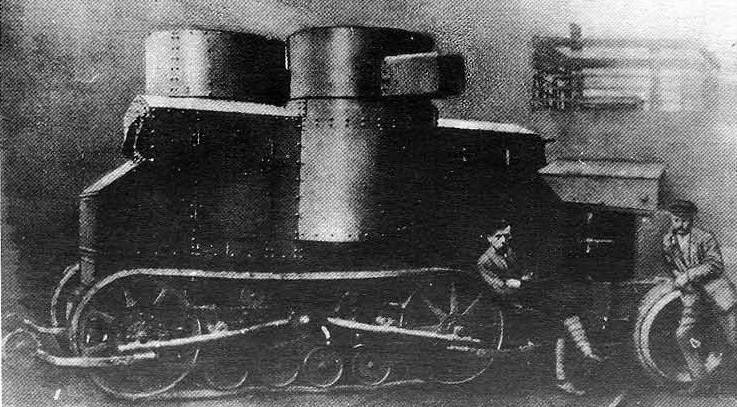
10. Austin Kegress. Photo 1919. Armor collection. 1997. No. 1.
It is necessary to mention the original 3-wheeled cannon-machine-gun armored cars, built by the Izhora plant and the officer rifle school, the armored car of Ensign Vonlyarlyarsky, the armored car "Burford" (booked in the Caucasus).
Finally, it is worth saying about Russian tank the program. This is not about the complex designs of the tanks of A. Porokhovshchikov (All-Terrain Vehicle) and N. Lebedenko (Tsar Tank), which were reasonably rejected by the GVTU, but about the following. Firstly, to complete the planned planned formation of the tank units of the Russian army was supposed in 1917 - 1918. purchase 360 Schneider tanks in France (there was interest in the British MK V tank); secondly, there was a real and accessible Russian production project - its object was a 12-ton tank armed with a three-inch gun and a machine gun (it was proposed by the Russian Renault Society to GVTU in late 1916).
Structurally in the Russian army at the end of 1917 - the beginning of 1918. More 12 armored divisions were to appear, equipped with full-drive FWD and Jeffrey armored vehicles, half-tracked armored cars (Kegress system) and tanks.
Used by the Russian army and armored - primarily on the Galician front. At the end of 1915, 15 armored trains operated on the Russian front - 8 on the South-West, 4 on the Caucasus, 1 on the North and West fronts and 1 in Finland (used for coastal coastal defense). The main thing in the tactics of armored trains is the activity of actions both in defense (strengthening the combat formations of troops) and in the offensive (making raids deep into the enemy's defense). For example, an armored train of the 2 Siberian Railway Battalion No. 3 at the beginning of June 1915 made a daring raid on the Austrian positions near the town of Krasny - breaking through the enemy defenses and struck an artillery strike on its rear.
Could the main armored forces of the Russian army of the First World War - armored cars - have a serious tactical or (all the more) operational influence on the course of military operations?
The tactical properties of an armored car, especially significant during a maneuverable war on a broad front, determined its role as a tool designed to deliver unexpected and violent blows to the enemy. The weak points of the armored car were dependence on high-quality dirt roads and a limited range.
Each armored car, together with a truck, a car and a motorcycle attached to it, made up a compartment. As we noted, three combat armor and one spare (usually) squad were combined into armor (auto-bullet) platoons. The latter gave the army corps. Armor platoons could be combined into divisions or companies.
Platoon staff - 4 officer, 60-65 of the lower ranks (drivers, machine-gunners, gunners and mechanics), who served three armored vehicles and an auxiliary semi-armored truck. As the eyewitness noted, the soldiers were excellent - especially machine-gunners and gunners, who knew their business well. Drivers of cars were often not at their best - resorting to various tricks to avoid combat situations. The officers, mostly volunteers, have always been on top. New genus weapons until he had a special tactic - everything was based on the common sense of the commander of the machine.
For combat use armored platoon allocated: 1) combat unit, which included only armored cars and motorcycles for reconnaissance and communications; 2) reserve - cars with a reserve of personnel and military equipment and 3) park (trucks).
Tactically, armored cars were considered expedient to use mainly on roads and small groups, since their main “advantage is speed”.
Armored cars carried out reconnaissance, supported infantrymen with fire, acted together with cavalrymen, conducted raids and defended the flanks of units and formations, used to strike the flank and rear, seize frontiers, and pursuit the enemy. Bronchium is an effective armored mobile reserve in the hands of an all-arms commander.
The first use of Russian armored vehicles took place during the Battle of Lodz 29. 10. - 06. 12. 1914. The operation began with an enemy attempt to encircle the 2 army, and ended with the exit from the encirclement of the Germans themselves - the shock group of the 9 army. The operation became the only successful world war example in which the Russian army was surrounded by a large enemy force (5 of the German divisions). And even in the "boiler" the enemy group was almost destroyed (losing 42000 people - to 90% of the composition) - the remnants managed to break out of the environment.
The key value acquired actions so-called. The Lovitsky Detachment, which closed the ring around the R. von Scheffer-Boyadel grouping. The Lovichsky detachment was actively supported by the 8 th armored car of the 1 th Auto-machine Company, attached to the 2 army.
9-10 November 1914. 6 machine-gun armored vehicles broke through the city of Strykov, occupied by German troops, while 2 cannon armored vehicles with artillery fire and maneuver supported the offensive of the 3 Turkestan rifle brigade. Caught in the grip of 2-x armored Germans, having suffered very heavy losses, were knocked out of the city.
November 20 The 1-I auto-pistol company ambushed at the junction between the left flank of the 19 Army Corps and the 5 Army in Pabianice. And at dawn 21-th five Russian armored cars destroyed the 2 regiment of the German infantry, who tried to begin to surround the left flank of the 19-Corps.
In these battles, the commander of 4 of the auto-bullet platoon proved to be the captain Pavel Vasilievich Gurdov. Covering the flank of the 68 infantry regiment of the Uglich regiment from the Germans, the armored cars approached Lasskoye Highway - finding a German maneuver. The document tells how the German infantry approached close to the highway - and Gurdov, crashing into the attacking enemy chains, opened fire from 4 machine guns from 100 - 150 meter distance. The Germans could not stand the dagger fire, and, stopping the offensive, lay down. But from such a distance the bullets pierced the armor - the crews were injured, and both armored vehicles were disabled. Shooting from 2-x machine guns, P. V. Gurdov with the help of wounded machine-gunners rolled the cars to the chains of the Russian infantry - and then they were towed.
P. Gurdov was awarded the Order of St. George 4-th degree, and the men of his platoon - George Crosses.
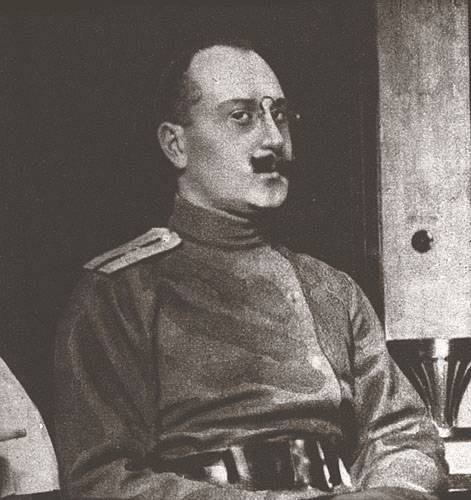
11. P. V. Gurdov.
Here is what the correspondent of P.V. Gurdov wrote about the feat of the platoon, citing interesting details: “From the very beginning of the war, the Austrians and, especially, the Germans frightened our troops with their machine guns on cars. There is a Russian cavalry, or a chain has crumbled - suddenly a car jumps out of an earthen elevation. He flies right in the forehead or along the front and showered our forces with a rain of bullets. Our infantry immediately lies down, starts firing at the car, but it has already gone. And in the chains here and there killed and wounded. ... And on November 11, 21, south of Lodz, our armored vehicles made their way along the Pabianitsa-Lask highway. On November 20, news was received that the German cavalry had stepped on the highway from Pabianica to Lask. It was ordered to make two platoons of machine-guns with a rapid-fire cannon making 300 rounds per minute and attack these columns. The command was assigned to Captain Gurdov, and the detachment immediately spoke out. Our battalion, which had restrained the offensive of the enemy, was to retreat under the murderous fire of the enemy. Just at that moment a detachment of cars arrived at the scene of the battle. In view of the enemy, Gurdov alone remained on the highway with his two armored vehicles. We had to stay until seven in the morning, when he was overtaken by ours. The officers with their bare swords quickly led their way forward, shouting to him: "Germans are attacking along the highway." The rattle of guns burst into deaf blows of artillery fire. Their batteries worked on both highways; between them all poured the lead infantry. ...
Already many have been killed and wounded. Every minute the swiftness of the German offensive intensified. Ours, too, hastily went to the counterattack, hurrying with a lively force to put an end to this onslaught of a superior enemy.
- Rather, machine guns ahead!
Gurdov rushed along the highway. On the one hand, there was a forest that seemed deserted, but when he reached the trees, shots burst out at close range. In more often sat down German arrows, hiding behind the trunks. At night, they took this closed position and now took full advantage of it. There was no time to stop and think. Hurricane bullets rushed to the right like thousands of hammers knocking on steel armor cars. This is not enough. Less than a few minutes, as the battery that noticed them from afar threw queues behind shrapnel lines. Beat from the side, struck from above, and the guns of the advancing German infantry worked point-blank. ... Dozens of accurately knocked down Germans lay in front of cars and in the forest. Machine guns, like iron brooms, swept them away, but others were put in place of the dead and wounded. Suddenly one of the cars turns back.
- Where? - shouts to his chauffeur Gurdov.
- Back to the village. I am wounded by shrapnel three times. If I stay, the car will be gone. In a few minutes he was bleeding to death; he lacked the strength to lead him.
Gurdov is back. He was followed by a second, with his sergeant. Gurdov, already injured himself in the neck, moved to a new car, and instead of the wounded driver, he placed the sergeant-major and ordered him to catch up with the forest. Again the battle of machine-guns began with everywhere attacking the enemy. ... The Germans fell both in front and in front. Gurdov watched only one thing - so that the shelling would not stop for a minute.
Cars brilliantly did their job. Enemy fire began to subside. ... At nine o'clock the fire his steel die out in the forest. Ahead of the Germans ebbed away. Their whole way was covered with corpses. The enemies barely had time to pick up their wounded ...
... They met the regiment commander. ...
- Take the highway ... There are enemy machine guns. They do terrible damage to us. Gurdov drove there.
Shooter proved to be great.
Ahead of the woods. In it an ambush. They are all laid down. Behind them, Gurdov sees a hollow in front. Machine guns followed her, and people ran across the hollow, occupying the trenches to the north, to Lask ... Gurdov instantly realized the state of affairs and immediately opened merciless fire on the hollow and at the trenches.
Resorts non-commissioned officer of the observation post.
- Your shells fit perfectly. The enemy is partly knocked out of the hollow and the trenches. Grouped at the brick factory to the right by the highway.
At this time, a platoon of cars of Captain Shulkevich drove up.
He earned by the hollow and the trenches, and Gurdov - by the brick factory, Again from the observation post:
- The Germans from the factory knocked out ... Run to the left in the village.
... It must have been an artillery park, as it was afterwards. Their machine guns were shot down and silenced ... Gurdov began to hit the indicated village, and suddenly a deafening explosion struck the whole neighborhood ... They rang far, and a huge cloud was thrown up, ... the village caught fire. The enemy was silent.
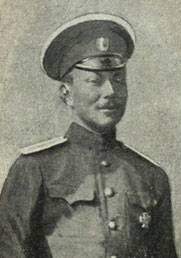
12. The commander of the 2 machine-gun platoon of the 1 th Autobunker Company, staff captain B. A. Shulkevich.
In this battle, the cannon armored car destroyed the German battery, an enemy brigade was defeated - and Russian armored cars, having parried the coverage of the flank of the 19 Army Corps, solved an important operational task.
The Stavka Summary provided details of the momentous battle: “At dusk on November 20, while heading for the forest, a significant German column was to cross the Pabianitsa-Lask Highway. At this time, our armored vehicles, armed with machine guns and cannons, crashed into the German column. The battle of our vehicles with the enemy was mostly at a distance of about 150 steps. The enemy suffered enormous damage from machine guns and grapeshot and completely dissipated. On our side, captain Gurdov, who commanded the car, was wounded and some machine-gunners. Two cars were damaged, but retained the ability to move. Headquarters captain Gurdov, having ordered the retreat of the cars damaged in the battle, being already wounded, moved into a car-cannon, replaced the wounded gunner, and continued to personally shoot the Germans. Then our cars also suddenly disappeared from the battlefield, as they appeared. In retaliation for the brilliant affair, the German 23 car battery in November boldly drove out before the front of our infantry division operating in the Krakow region, but now one car was overturned by the fire of our field batteries; other cars were saved at full speed. Also in the Lodz region, we had to meet with a German armored car, which approached very close to our trench, which wounded our guards and retreated hastily. Our troops are welcomed by armored vehicles that have arrived in the army, which can significantly facilitate the combat work of the troops at night, in fog and under other conditions that allow us not to fear enemy artillery. ”
13. Niva. 1915. No. 4.
We see that in the Battle of Lodz the Russian armored cars defeated the Strykov garrison, and under the Pabianians they destroyed the 2 regiment - solving not only tactical, but also operational tasks.
To be continued
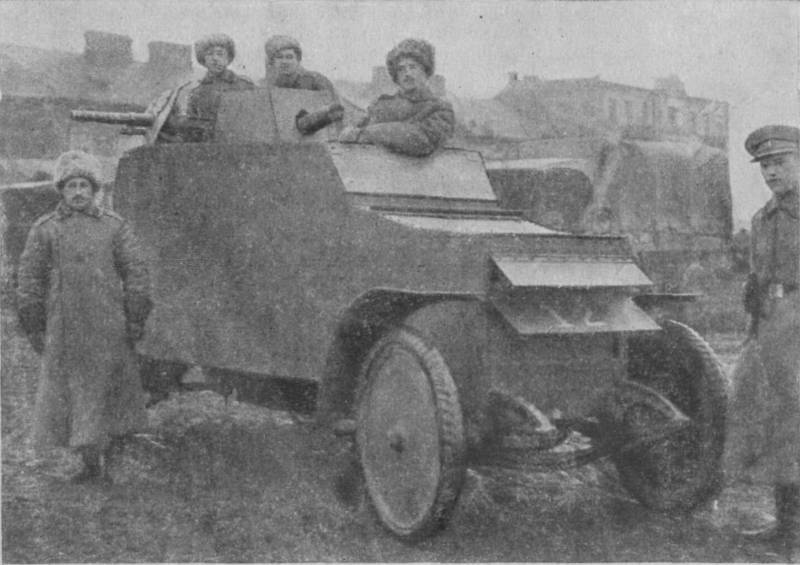
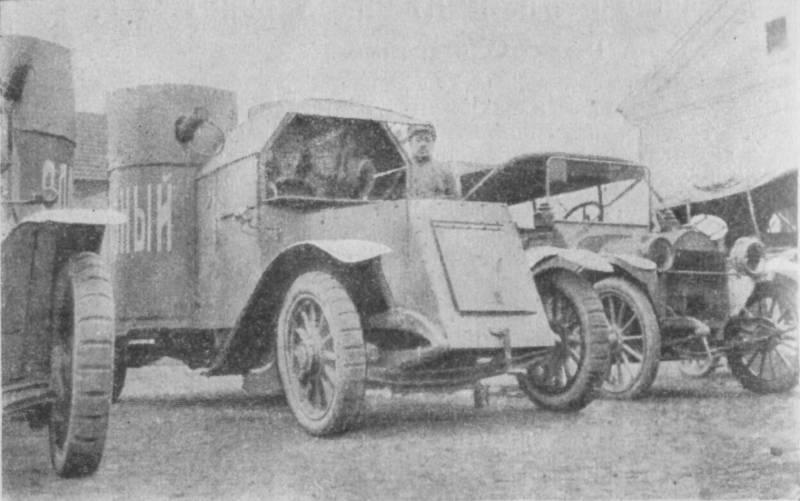
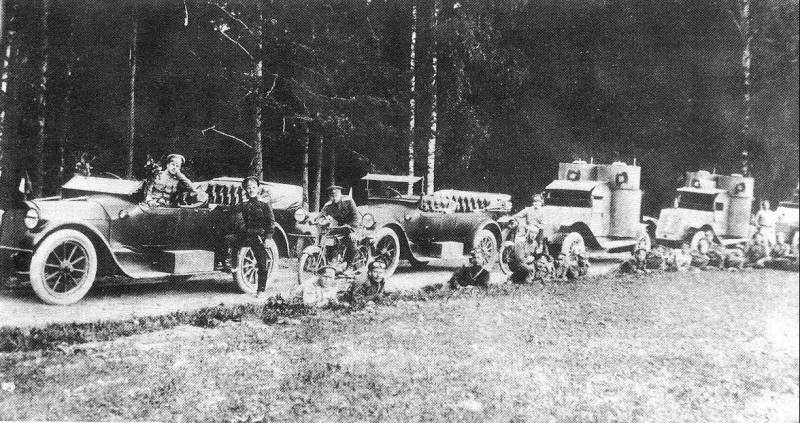
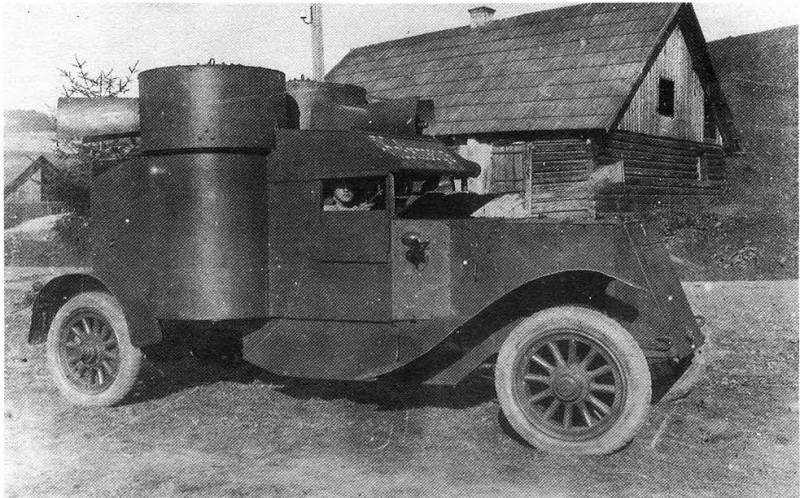
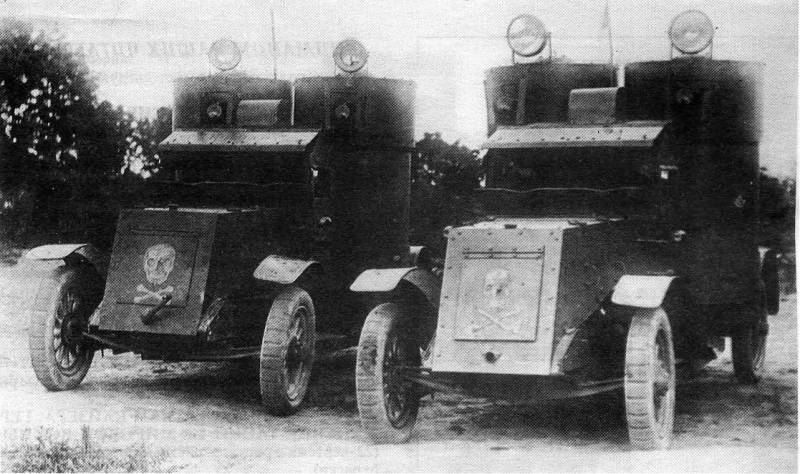
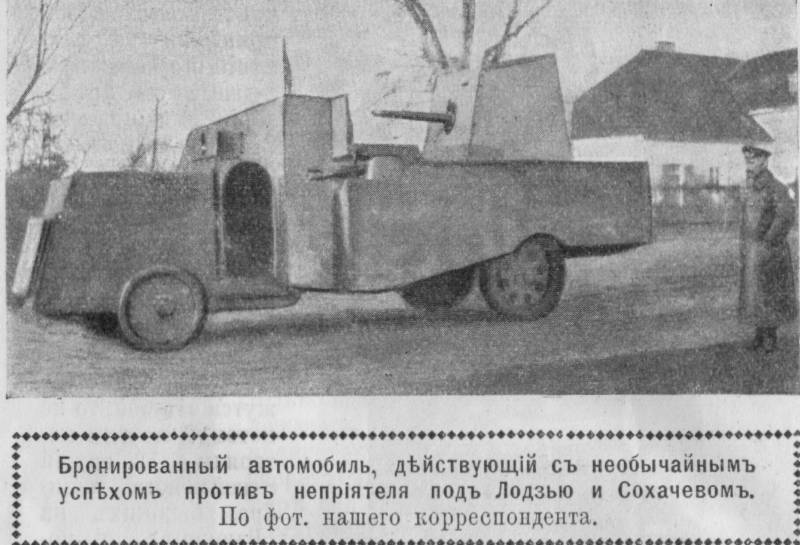
Information